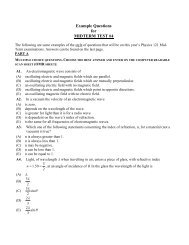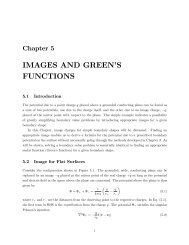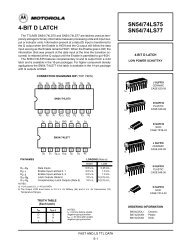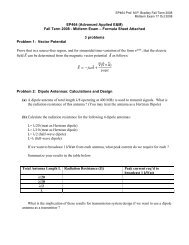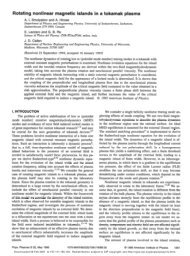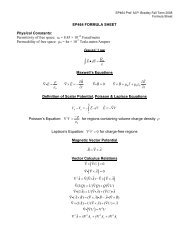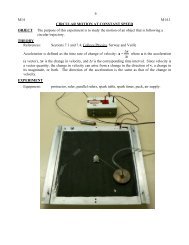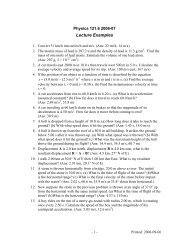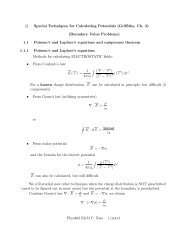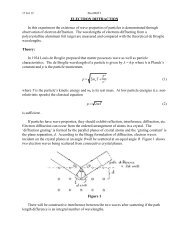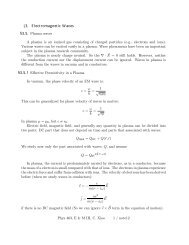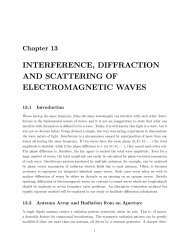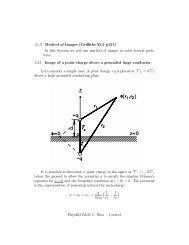electrostatics i electric field and scalar potential - Department of ...
electrostatics i electric field and scalar potential - Department of ...
electrostatics i electric field and scalar potential - Department of ...
Create successful ePaper yourself
Turn your PDF publications into a flip-book with our unique Google optimized e-Paper software.
Chapter 1ELECTROSTATICS IELECTRIC FIELD AND SCALARPOTENTIAL1.1 IntroductionAtoms <strong>and</strong> molecules under normal circumstances contain equal number <strong>of</strong> protons <strong>and</strong> electrons tomaintain macroscopic charge neutrality. However, charge neutrality can be disturbed rather easilyas we <strong>of</strong>ten experience in daily life. "Static <strong>electric</strong>ity" induced when walking on a carpet <strong>and</strong>caressing a cat is a familiar phenomenon, <strong>and</strong> is known as frictional (or tribo) <strong>electric</strong>ity. Beforethe invention <strong>of</strong> chemical batteries (Volta, 1786), <strong>electric</strong>ity generation had been largely done byfrictional <strong>electric</strong>ity generators. In nature, lightnings are caused by <strong>electric</strong>al discharges <strong>of</strong> <strong>electric</strong>charges accumulated through friction among cloud particles. In frictional <strong>electric</strong>ity, mechanicaldisturbance given to otherwise charge neutral molecules either splits electrons o¤ a material body,or adds them. For example, if an ebony rod is rubbed with a piece <strong>of</strong> fur, electrons are transferedfrom the fur to the ebony, <strong>and</strong> the ebony rod becomes negatively charged, while the fur becomespositively charged.Charge neutrality can be disturbed by various other means, such as thermal, chemical, optical<strong>and</strong> electromagnetic disturbances. It is well known that even a c<strong>and</strong>le ‡ame is weakly ionized(cuased by thermal ionization) <strong>and</strong> responds to an <strong>electric</strong> …eld. Chemical batteries are capable,through chemical reactions, <strong>of</strong> separating charges. Some metals are known to emit electrons whenexposed to ultraviolet light (photo<strong>electric</strong> e¤ect discovered by Hertz in 1897 <strong>and</strong> later given quantummechanical explanation by Einstein). Finally, as an example <strong>of</strong> electromagnetic means <strong>of</strong> chargeseparation, the plasma (ionized gas) state in ‡uorescent lamps <strong>and</strong> plasma TV may be added tothe list.Charged bodies exert <strong>electric</strong> forces (Coulomb force) on each other. Systematic experimentson <strong>electric</strong> forces had been carried out by Cavendish <strong>and</strong> Coulomb in the 18th century <strong>and</strong> led1
to the establishment <strong>of</strong> the Coulomb’s law. Like charges repel each other, while unlike chargesattract each other. Therefore, in any attempt to separate charges out <strong>of</strong> an initially charge neutralbody, energy must be added. For example, in frictional <strong>electric</strong>ity, mechanical energy is expendedto separate charges. In chemical batteries, chemical energy is converted into <strong>electric</strong> energy, <strong>and</strong>in <strong>electric</strong> generators, either gravitational (as in hydropower generation) or thermal (as in steampower plants) energy is converted into <strong>electric</strong> energy.The Coulomb force to act between two charges is inversely proportional to r 2 where r is theseparation distance between the charges. A hydrogen atom consists <strong>of</strong> one electron ”revolving”around a proton. The centripetal Coulomb force (attracting) is counterbalanced by the mechanicalcentrifugal force, <strong>and</strong> the electron stays on a circular orbit. (This is a classical electrodynamicmodel. For a more satisfactory description <strong>of</strong> a hydrogen atom, quantum mechanical analysis isrequired. However, the concept <strong>of</strong> force balance is basically correct.) A nucleus <strong>of</strong> heavier atomscontains more than one proton. The size <strong>of</strong> a nucleus is <strong>of</strong> order 10 15 m (compare this with theatomic size 10 10 m). Therefore, among the protons packed in a nucleus, a tremendously largerepelling Coulomb force should act, <strong>and</strong> some other force, which is not <strong>of</strong> <strong>electric</strong> nature, mustkeep protons together. This is provided by the so-called ”strong” nuclear force which acts amonghadrons such as protons <strong>and</strong> neutrons. Obviously, the nature <strong>of</strong> nuclear force is beyond the realm <strong>of</strong>classical electrodynamics. However, it should be realized that nuclear energy that can be releasedwhen a heavy nucleus (such as U 235 ) splits (nuclear …ssion process) is nothing but <strong>electric</strong> energystored in a nucleus.Electrostatics is one branch <strong>of</strong> electrodynamics in which <strong>electric</strong> charges are either stationaryor moving su¢ ciently slowly so that magnetic …eld induction <strong>and</strong> electromagnetic radiation can beignored entirely. All basic laws in <strong>electrostatics</strong> (Gauss’law, Maxwell’s equations) follow from theCoulomb’s law. Therefore, formulating the <strong>electric</strong> …eld <strong>and</strong> <strong>scalar</strong> <strong>potential</strong> in <strong>electrostatics</strong> will bededuced from this fundamental law. It should be pointed out that <strong>electrostatics</strong> (together with magnetostatics)provides us with preparation for more general electrodynamics, electromagnetic wavephenomena in particular. For example, electromagnetic wave propagation in a medium (includingvacuum) requires that the medium be able to store both <strong>electric</strong> <strong>and</strong> magnetic energy. Obviously,<strong>electric</strong> energy storage leads us to the concept <strong>of</strong> capacitance. Calculation <strong>of</strong> the capacitance <strong>of</strong> agiven electrode system is one important application <strong>of</strong> <strong>electrostatics</strong>, but the concept <strong>of</strong> capacitance(<strong>and</strong> inductance) will also play fundamental roles in dynamic electromagnetic phenomena.1.2 Coulomb’s LawIn the late 1700’s, Cavendish <strong>and</strong>, independently, Coulomb carried out extensive research on static<strong>electric</strong>ity. (At that time, no batteries were available, <strong>and</strong> <strong>electric</strong>ity generation was mainly donewith frictional <strong>electric</strong>ity machines.) Apparently, Cavendish’s discovery <strong>of</strong> the inverse square law,now known as Coulomb’s law, was made before Coulomb. However, Cavendish did not publishhis large amount <strong>of</strong> work on <strong>electric</strong>ity, while Coulomb wrote several papers on <strong>electric</strong>ity <strong>and</strong>magnetism. Of course, Cavendish is best known for his gravitational torsion balance experiments2
which experimentally veri…ed the inverse square law <strong>of</strong> gravitational force originally postulated byNewton. Both Cavendish <strong>and</strong> Coulomb used similar torsion balance apparatus to measure <strong>electric</strong>forces acting between charged bodies.Coulomb’s law is stated as follows. When two charges q 1 <strong>and</strong> q 2 are at a distance r from eachother, the <strong>electric</strong> force exerted on each other is proportional to q 1q 2r 2 ,F = const. q 1q 2r 2 : (1.1)In the MKS-Ampere unit system (SI unit system), the charge is measured in Coulombs (C), thedistance in meters (m), <strong>and</strong> the force in Newtons (N). In these units, the constant experimentallydetermined is N mconstant = 8:99 10 9 2C 2Figure 1-1: Repelling Coulomb force between like charges.The force is a vector quantity. In the case <strong>of</strong> the Coulomb force, the force is directed along theseparation distance vector r, <strong>and</strong> a more formal expression is given byF = const. q 1q 2r 2 e r (1.2)wheree r = r r(1.3)is the unit vector along the position vector r. Of course, both charges q 1 <strong>and</strong> q 2 experience aforce <strong>of</strong> the same magnitude, but oppositely directed. The sign <strong>of</strong> the product q 1 q 2 can be eitherpositive or negative. When q 1 q 2 > 0, the force is repelling, <strong>and</strong> when q 1 q 2 < 0, the force isattractive. In the 18th century when Cavendish <strong>and</strong> Coulomb conducted experiments, the presence3
<strong>of</strong> two kinds <strong>of</strong> charges, positive <strong>and</strong> negative, was known although their origin, namely chargedelementary particles, was clari…ed much later. The electron was discovered by Thomson in 1897.The electronic charge presently established is1:6 10 19 Coulomb.The proportional constant in the Coulomb’s law corresponds to the force to act between twoequal charges, 1 C each, separated by a distance <strong>of</strong> 1 m.By arranging such an experimentalsituation, the constant could be measured as done by Cavendish <strong>and</strong> Coulomb. (In more modernmethods, the velocity <strong>of</strong> light in vacuum provides an indirect measurement <strong>of</strong> the constant. Thiswill become clear later in Chapter 7.) In the MKS-Ampere unit system, the connection betweenmechanical force (Newtons) <strong>and</strong> basic electromagnetic unit is actually made in terms <strong>of</strong> magneticforce, rather than the Coulomb force, as will be explained in Chapter 7. When two long parallelcurrents <strong>of</strong> equal magnitude separated 1 m exert a force per unit length <strong>of</strong> 2 10 7 N/m, themagnitude <strong>of</strong> the current is de…ned to be 1 Ampere. The <strong>electric</strong> charge, 1 C, is then deducedfrom,1 C = 1 Ampere 1 secIn other unit systems, the Coulomb’s law itself is employed to de…ne the unit <strong>of</strong> <strong>electric</strong> charges. Forexample, in the CGS-ESU (ESU for ElectroStatic Unit) system, when two equal charges separatedby 1 cm exert a force <strong>of</strong> 1 dyne on each other, the charge is de…ned to be 1 ESU. Since 1 N = 10 7dyne, <strong>and</strong> 1 m = 10 2 cm, we can readily see that1 C =For example, the electronic charge in ESU is1 ESUp8:99 10 18 '1 ESU3:0 10 91:6 10 19 3:0 10 9 = 4:8 10 10 ESUAlthough in engineering, the MKS-Ampere (SI) unit system is universally accepted, the CGS-ESU<strong>and</strong> associated Gaussian unit system is still popular in physics. Both have merits <strong>and</strong> demerits,<strong>and</strong> it is di¢ cult to judge one unit system superior to the other.In the MKS-Ampere unit system, the Coulomb’s lawis rewritten aswhereF = 8:98 10 9 q 1q 2r 2 e r (N) (1.4)F = 14 0q 1 q 2r 2 e r (N) (1.5) 0 = 8:85 10 12 C 2N m 2 (1.6)is called the vacuum permittivity. The appearance <strong>of</strong> the numerical factor 4 may be uncomfortable,but cannot be entirely avoided. If we do not introduce the factor 4 in the Coulomb’s law, it willpop up in the corresponding Maxwell’s equation. In fact, the Maxwell’s equation for the static4
Figure 1-2: In MKS unit system, I = 1 Ampere current is de…ned if the force per unit length betweenin…nite parallel currents 1 m apart is 2 10 7 N/m. The magnetic permeability 0 = 4 10 7H/m is an assigned constant to de…ne 1 Ampere current.<strong>electric</strong> …eld in the CGS-ESU system has to be written asrE = 4 (1.7)because the factor 4 is avoided in the corresponding Coulomb’s law,F = q 1q 2r 2 e r (dynes)The newly introduced constant 0 is one <strong>of</strong> the fundamental constants in electrodynamics. Notethat 0 is a measured constant, since it is derived from the original measured constant, 8:99 10 9Nm 2 /C in the Coulomb’s law. The permittivity <strong>of</strong> air (room temperature, 1 atmospheric pressure)is about 1:0004 0 due to the polarizability <strong>of</strong> air molecules. For practical applications, the airpermittivity can be very well approximated by the vacuum permittivity.1.3 Electric Field EInterpretation <strong>of</strong> Coulomb’s law was a matter <strong>of</strong> debate before the concept <strong>of</strong> <strong>electric</strong> …eld waswell established by Faraday <strong>and</strong> Maxwell. Before Faraday <strong>and</strong> Maxwell, the so-called “theory <strong>of</strong>action at distance” once prevailed. According to this theory, <strong>electric</strong> e¤ects (such as Coulombforce) appear through some sort <strong>of</strong> direct interaction between charges, <strong>and</strong> space (or vacuum)has nothing to do with the interaction. In the “…eld” theory, a single charge “disturbs” spacesurrounding it by creating an <strong>electric</strong> …eld. The Coulomb force to act between two charges is due5
to interaction between one charge <strong>and</strong> the <strong>electric</strong> …eld produced by the other. The …eld theoryis now well accepted, <strong>and</strong> modern electrodynamics is almost entirely described by …eld quantitiessuch as <strong>electric</strong> <strong>and</strong> magnetic …elds.Let us write down the Coulomb force again,This can be written eitherorF = 1 q 1 q 24 0 r 2e rF = 14 0q 1r 2 e r q 2 (1.8)F = 14 0q 2r 2 e r q 1 (1.9)We may interpret Eq. (1.8) as the force experienced by a charge q 2 placed in an <strong>electric</strong> …eld,E 1 = 14 0q 1r 2 e r (1.10)produced by a charge q 1 while Eq. (1.9) as the force experienced by a charge q 1 placed in an <strong>electric</strong>…eld,produced by a charge q 2 .<strong>electric</strong> …eld given byregardless <strong>of</strong> the presence <strong>of</strong> a second charge.E 2 = 14 0q 2r 2 e r (1.11)A single charge q in the space with a permittivity thus produces anE = 14 0qr 2 e r (N/C) (1.12)Numerically, the <strong>electric</strong> …eld is equivalent to aforce to act on a unit change. Since the force is a vector, so is the <strong>electric</strong> …eld, <strong>and</strong> completedetermination <strong>of</strong> an <strong>electric</strong> …eld requires three spatial components.byIn general, if a charge q is placed in an <strong>electric</strong> …eld E, the force to act on the charge is givenF = qE (N) (1.13)This may alternatively be used for de…nition <strong>of</strong> an <strong>electric</strong> …eld, namely, if a stationary charge qexperiences a force proportional to the amount <strong>of</strong> the charge, then we de…ne that an <strong>electric</strong> …eld ispresent. (Elementary particles such as protons <strong>and</strong> electrons do have masses, <strong>and</strong> they experiencegravitational forces as well. However, gravitational forces are orders <strong>of</strong> magnitude smaller thanelectromagnetic forces, <strong>and</strong> in most practical applications, gravitational forces can be ignored.)Although Eq. (1.12) has been deduced from Coulomb’s law, the inverse is not always true, that is,<strong>electric</strong> …elds are not necessarily due directly to charges. A time varying magnetic …eld producesan <strong>electric</strong> …eld (Faraday’s law). Also, an object travelling across a magnetic …eld experiences an<strong>electric</strong> …eld (motional electromotive force), as we will study in Chapter 9. However, regardless <strong>of</strong>the origin <strong>of</strong> the <strong>electric</strong> …eld, the force equation, Eq. (1.12), holds.6
E2E tq1PE1qFigure 1-3: Vectorial superposition <strong>of</strong> <strong>electric</strong> …eld.21.4 Principle <strong>of</strong> Superposition <strong>and</strong> Electric Field due to a DistributedChargeThe expression for the <strong>electric</strong> …eld due to a point charge,E = 14 0qr 2 e r (1.14)can be applied repeatedly to …nd an <strong>electric</strong> …eld due to a system <strong>of</strong> charges. For example, if thereare two charges q 1 at r 1 <strong>and</strong> q 2 at r 2 , the total …eld can be found from,Note that the quantities,E = 14 0r r 1jr r 1 j 3 q 1 + 14 0r r 2jr r 2 j 3 q 2 (1.15)r r 1jr r 1 j ; r r 2jr r 2 jare the unit vectors in the directions r r 1 <strong>and</strong> r r 2 , respectively. For larger number <strong>of</strong> charges,the total <strong>electric</strong> …eld can still be found as vector sum <strong>of</strong> <strong>electric</strong> …elds due to individual charges.This is known as the principle <strong>of</strong> superposition. For N discrete charges, the <strong>electric</strong> …eld can bewritten down as,E = 14 0N Xi=1r r ijr r i j 3 q i (1.16)As the number <strong>of</strong> charges increases, the summation becomes rather awkward. In most practicalapplications, the charge distribution can be regarded continuous, rather than discrete.As one7
would expect, the summation in the case <strong>of</strong> discrete charges can be replaced by an integral in thecase <strong>of</strong> a continuous charge distribution.,A continuous charge distribution can be described by a local charge density,(r) (C/m 3 )which may vary as a function <strong>of</strong> position r. Since the size <strong>of</strong> elementary particles is so small, acollection <strong>of</strong> those particles (e.g. electrons) can be well approximated by a continuous function(r), just as we treat water as a ‡uid although, microscopically, water consists <strong>of</strong> discrete watermolecules.Let us pick up a small volume dV 0 located at a distance r 0 from a reference point O as shownin Fig. 1.4. The charge contained in the volume dV 0 located at r 0 isdq = (r 0 )dV 0By choosing the volume element su¢ ciently small, we may regard the charge dq a point charge.We already know how to express the <strong>electric</strong> …eld due to a point charge,dE ==1 dq(r r 0 )4 0 jr r 0 j 31 r r 04 0 jr r 0 j 3 (r0 )dV 0 (1.17)Therefore, the <strong>electric</strong> …eld at r can be calculated from the following integral,ZE(r) =dE = 14 0Zr r 0jr r 0 j 3 (r0 )dV 0 (1.18)This is a general formula for calculating an <strong>electric</strong> …eld due to an arbitrary distribution <strong>of</strong> charges.Remember that we have derived it from the Coulomb’s law.Although the formula we just derived is a complete solution for static <strong>electric</strong> …elds due to acharge distribution, it is seldom used in practical applications except for simple (or <strong>of</strong>ten trivial)cases. There are several reasons for this. First, Eq. (1.18) is a vector equation. In the cartesiancoordinates, for example, three components, E x ; E y <strong>and</strong> E z will have to be evaluated separately.That is, we have to carry out integrations three times for a complete vector solution. Second, inmany <strong>potential</strong> boundary value problems, the charge distribution, (r), is not known a priori. Forexample, in evaluation <strong>of</strong> a capacitance <strong>of</strong> a given electrode system, the problem is reversed, thatis, we calculate the <strong>electric</strong> …eld (from the <strong>scalar</strong> <strong>potential</strong>) …rst, <strong>and</strong> then evaluate the chargedistribution on the surface <strong>of</strong> electrodes.As we will study in Section 2, the method based onthe <strong>scalar</strong> <strong>potential</strong> is more convenient in practical applications than evaluating the <strong>electric</strong> …eldusing Eq. (1.18). However, if the charge distribution is known, we can certainly use Eq. (1.18) toevaluate the <strong>electric</strong> …eld at an arbitrary point. Let us work on some simple examples.8
dEr r'dq =ρdV'rr'OFigure 1-4: Di¤erential charge dq = dV 0 produces a di¤erential <strong>electric</strong> …eld dE:Charge SheetLet a large, thin insulating sheet carry a uniform surface charge density (C/m 2 ) (= constant).If the sheet is large enough, or the point at which we wish to evaluate the <strong>electric</strong> …eld is closeenough to the sheet, the <strong>electric</strong> …eld should be perpendicular to the sheet because <strong>of</strong> cancellationby an element located opposite with respect to the origin O. Choosing the cartesian coordinatesx; y; z, we then have to evaluate only the z component <strong>of</strong> the <strong>electric</strong> …eld at a distance z from thesheet.Let us pick up a surface element dx 0 dy 0 located at (x 0 ; y 0 ; z 0 = 0) on the sheet. The elementcarries a “point charge”dq = dx 0 dy 0 . Then, the magnitude <strong>of</strong> the <strong>electric</strong> …eld on the z axis is,<strong>and</strong> its z component is,dE = 14 0dx 0 dy 0x 02 + y 02 + z 2 (1.19)dE z = 1 z4 0 (x 02 + y 02 + z 2 ) 3=2 dx0 dy 0 (1.20)Therefore, the <strong>electric</strong> …eld on the axis is given by the following integral,E z =z Z 1 1dx4 0 1Z 0 dy 01 (x 02 + y 02 + z 2 ) 3=2 (1.21)However, the double surface integral can be replaced by a single integral over the radius r 0 , wherer 02 = x 02 + y 02 so thatE z =z Z 12r 04 0 0 (r 02 + z 2 ) 3=2 dr0 (1.22)9
The integral is elementary, <strong>and</strong> we …ndE z = z2 0= 2 0zjzj1 r 0 =1pr 02 + z 2r 0 =0(1.23)where p z 2 = jzj has been substituted.The solution indicates that the magnitude <strong>of</strong> the <strong>electric</strong> …eld is independent <strong>of</strong> the distancefrom the sheet. The direction <strong>of</strong> the <strong>electric</strong> …eld is negative in the region z < 0, <strong>and</strong> positive forz > 0. When there are two oppositely charged sheets, <strong>and</strong> (C/m 2 ), the <strong>electric</strong> …eld outsidethe sheets if zero, but the …eld in between the sheets is given by,E z = (1.24) 0as can be readily seen from the principle <strong>of</strong> superposition. This con…guration corresponds to aparallel plate capacitor provided the edge e¤ects are ignored.Line ChargeWe assume a long line charge with a line charge density (C/m). At a distance r from the linecharge, the di¤erential <strong>electric</strong> …eld due to a charge dq = dz located at z isdE = 1 dz4 0 r 2 + z 2 (cos e r + sin e z ) (1.25)where,cos =rpr 2 + z ; sin = zp 2 r 2 + z 2The z component is an odd function <strong>of</strong> z. Therefore, the z component <strong>of</strong> the <strong>electric</strong> …eld vanishesafter integration from z =1 to +1. The radial (r) component remains …nite, <strong>and</strong> is given by,E r = Z 1r4 0 1 (r 2 + z 2 dz =) 3=2 2 0 r(1.26)Remember that this result is valid only if the line charge is long, or the point <strong>of</strong> observation issu¢ ciently close to a line charge <strong>of</strong> …nite length.1.5 Gauss’Law for Static Electric FieldThe <strong>electric</strong> …eld at a distance r from a point charge q is,E = 14 0qr 2 e r;10
chargesheet σ(C/m 2 )E =σ/2ε 0E =σ/2ε 0σ−σE = 0E = 0E =σ/ε 0Figure 1-5: Upper …gure: Single charge sheet. The <strong>electric</strong> …eld on both sides is E z = =2" 0 : Lower…gure: Equal, opposite charge sheets. The …eld in-between is E z = =" 0: Outside, E z = 0:dE rdEdEzdq=λdzzrline chargezFigure 1-6: Electric …eld due to a long line charge (line charge density C/m). Note that E z = 0<strong>and</strong> the radial <strong>electric</strong> …eld E r = can also be found using Gauss’law.2" 0 r11
dE nrθγaqbFigure 1-7: Gauss’law applied to a sphere that is not concentric with the charge. Note r cos +b cos = a:On a spherical surface with radius r, the magnitude <strong>of</strong> the <strong>electric</strong> …eld is constant, <strong>and</strong> the quantity,4r 2 E ris equal to q= 0 . This strongly suggests that the closed surface integral <strong>of</strong> the <strong>electric</strong> …eld,IEdS (1.27)is equal to the amount <strong>of</strong> charge enclosed by the closed surface S divided by 0 ,IEdS = qS " 0SNoting<strong>and</strong>ISZEdS =Zq =r EdV (r) dVwe …nd the Maxwell’s equationr E = " 0Let us see if this is the case for a spherical surface which is not concentric with the point chargeq. We denote the distance between the charge <strong>and</strong> the spherical center by b, <strong>and</strong> the radius <strong>of</strong> thesphere by a.The <strong>electric</strong> …eld on the surface is no more uniform. It is not normal to the surface, either. Noting12
the relationship,r 2 = a 2 + b 22ab cos in Fig. ??, we …nd the magnitude <strong>of</strong> the <strong>electric</strong> …eld at angle ,E =q 14 0 a 2 + b 2 2ab cos (1.28)The component normal to the spherical surface is E cos where the angle is related to throughTherefore, the entire surface integral reduces to,ISE dS =q Z 4 0r cos + b cos = a:0a b cos (a 2 + b 2 2ab cos ) 3=2 2a2 sin d (1.29)wheredS = 2a 2 sin dis the area <strong>of</strong> the ring having radius asin <strong>and</strong> width ad. The relevant integral isZ 0(a b cos ) sin (a 2 + b 2 2ab cos ) 3=2 d = 8 b0; a < b(1.30)(In integration, it is convenient to change the variable from to through = cos . Then theintegral reduces to=1b p a 2 + b 2R 11a b(a 2 + b 2 d2ab) 3=2 11 a 2 + b 22aba 2 pb a 2 + b 21ab2ab11Evaluation <strong>of</strong> the de…nite integral is left for a mathematical exercise. Note that p (a b) 2 = ja bj.)Therefore, the surface integral <strong>of</strong> the <strong>electric</strong> …eld becomes,I8< q; a > bEdS = 0: 0; a < b(1.31)Obviously, the case a > b corresponds to a sphere enclosing the charge, <strong>and</strong> a < b corresponds tothe case in which the charge is outside the closed spherical surface. The result may be generalizedto a closed surface <strong>of</strong> an arbitrary shape. The following formula is called Gauss’law, 0ISEdS = qTotal chargeenclosed by S!(1.32)13
Again, remember that Gauss’ law is equivalent to Coulomb’s law, since we have “deduced” theformer from the latter. In fact, Gauss’law can be mathematically “proven”if we adopt Coulomb’slaw. A formal pro<strong>of</strong> will be given after the Maxwell’s equation is introduced.Gauss’law can be convenient for simple cases in which a system has a high degree <strong>of</strong> symmetry,such as spherical, cylindrical, <strong>and</strong> planar symmetries. Let us work on a few simple examples.Uniformly-Charged Insulating SphereLet an insulating sphere <strong>of</strong> radius a carry a uniform charge density (C/m 3 ) <strong>and</strong> a total chargeq = 4 3 a3 (C). The system has complete spherical symmetry, <strong>and</strong> the only nonvanishing component<strong>of</strong> the <strong>electric</strong> …eld is the radial component, E r . Outside the sphere (r > a), Gauss’law yields,4r 2 E r = q 0orE r =q4 0=a33 0 r 2 (1.33)which is identical to the …eld due to a point charge q concentrated at the center. Inside the sphere(r < a), Gauss’law reads4r 2 E r = 1 043 r3 (1.34)since in the RHS, only the amount <strong>of</strong> charge enclosed by the spherical surface (called Gaussiansurface) having a radius r (< a) enters. Solving for E r , we obtain,E r =3 0r (1.35)Therefore, in the sphere, the …eld linearly increases with the radius r up to the surface, r = a, wherethe interior …eld connects to the exterior …eld without dicontinuity. The <strong>electric</strong> …eld is maximumat the surface as shown in Fig. 1-8.The fact that the <strong>electric</strong> …eld should vanish at the center <strong>of</strong> a charged (uniformly!) sphere isunderst<strong>and</strong>able from spherical symmetry. At the center, the contribution from a charge dq to the<strong>electric</strong> …eld can always be cancelled by another located opposite with respect to the center. Byanalogy, the gravitational …eld due to the earth mass itself at the earth’s center should be zero.Charged Conducting SphereA charge given to a conductor must reside entirely on the conductor surface so that the <strong>electric</strong>…eld inside a conductor body should be identically zero in static condition. If an <strong>electric</strong> …eld werenot zero in a conductor, a large <strong>electric</strong> current would ‡ow according to Ohm’s law,J = E (1.36)where (Siemens/m) is the conductivity. <strong>of</strong> metals is large. (For example, copper has '5:9 10 7 S/m). Therefore, unless E = 0 in a conductor, a large current should ‡ow, <strong>and</strong> thisviolates the assumption <strong>of</strong> static <strong>electric</strong>ity. In other words, an <strong>electric</strong> …eld can exist in a conductor14
ErE maxa 2a 3a 4arρaFigure 1-8: Electric …eld <strong>of</strong> a unifrmly charged sphere. The …eld is 0 at the center. The maximum…eld, E max = a3" 0; occurs at the surface.only in dynamic conditions in which current ‡ow is allowed.If an excess charge q is given to a conducting sphere, the charge uniformly resides on the surfaceas a surface charge, with a surface charge density s = q=4a 2 (C/m 2 ) where a is the sphere radius.The <strong>electric</strong> …eld inside (r < a) the sphere is zero, while outside (r > a), it is given byE r = 14 0qr 2 (r > a) (1.37)Note that there is a sudden jump in the …eld at the surface (r = a) where the surface charge densityexists. In general, wherever an in…nitesimaly thin surface charge layer exists, the <strong>electric</strong> …eld therebecomes discontinuous. We will come back to this subject in Chapter 3 where the concept <strong>of</strong> thedisplacement vector D is introduced.Experimental Veri…cation <strong>of</strong> Coulomb’s Inverse Square LawAs stated earlier, Gauss’law <strong>and</strong> Coulomb’s law are physically identical, in the sense that theformer is derivable from the latter. Therefore, if Gauss’law can be veri…ed experimentally, thenCoulomb’s law is indirectly veri…ed also. Here, we are particularly concerned with a question: Howvalid is the inverse square law? Or put alternatively, when the Coulomb’s law is written asF = const:r n e rhow close is the power n to 2.0? Is it exactly 2.0? Experiments in the past have shown that n is15
ErE maxa 2a 3a 4arσaconducting spherecarrying a surfacechargeFigure 1-9: Electric …eld in a charged conducting sphere is 0. The charge q given to the spheremust reside on the surface as a surface charge = q=4a 2 C/m 2 :indeed very close to 2.0 with an uncertainty <strong>of</strong> order 10 16 . The power n is probably exactly equalto 2.The experiment performed by Plimpton <strong>and</strong> Lawton in 1936 was to measure the intensity <strong>of</strong><strong>electric</strong> …eld inside a charged conducting shell. As we have just seen in the preceding example, anexcess charge given to a conductor must reside entirely on its outer surface, <strong>and</strong> the <strong>electric</strong> …eld inthe conductor must be zero. This holds for a conducting shell, too, <strong>and</strong> no charge can exist on theinner surface <strong>of</strong> the shell. Plimpton <strong>and</strong> Lawton established n = 2210 9 . Further improvementn = 2 2 10 16 was achieved later in 1971 by Williams et al.1.6 Di¤erential Equations for Static Electric Fields-Maxwell’s EquationsFor a given charge distribution (r), the <strong>electric</strong> …eld can be uniquely evaluated fromE(r) = 14 0Z r r0jr r 0 j 3 (r0 )dV 0 (1.38)as we have seen in Sec. 1.4. The <strong>electric</strong> …eld also satis…es Gauss’law,ISEdS = 1 0ZV(r)dV (1.39)16
We may use either formulation in evaluating the <strong>electric</strong> …eld due to a prescribed charge distribution.The <strong>electric</strong> …eld is a vector quantity. A vector can be uniquely de…ned if its divergence <strong>and</strong>curl are both speci…ed. This mathematical theorem is known as Kirchho¤’s theorem. (Kirchho¤is a familiar name in <strong>electric</strong> circuit theory. However, his contributions are not limited to circuittheory, but quite diversi…ed.Kirchho¤’s <strong>scalar</strong> di¤raction formula for electromagnetic waves isanother important contribution, <strong>and</strong> had been used extensively until it was replaced by a moreaccurate vector di¤raction formula rather recently. See Chapter 13.) A derivation <strong>of</strong> vector di¤erentialequations for <strong>electric</strong> <strong>and</strong> magnetic …elds was formulated by Maxwell in the celebrated book“Treatise on Electricity <strong>and</strong> Magnetism” published in 1873.Each …eld (<strong>electric</strong> <strong>and</strong> magnetic)requires both divergence <strong>and</strong> curl. Therefore, for complete description <strong>of</strong> <strong>electric</strong> <strong>and</strong> magnetic…elds, four Maxwell’s equations emerge.In <strong>electrostatics</strong>, the magnetic …eld is absent (or ignored). Let us start with the divergence <strong>of</strong>static <strong>electric</strong> …elds. In the example <strong>of</strong> a charged sphere in Sec. 2.5, we have seen that the <strong>electric</strong>…eld inside a uniformly charged spherical body can be found from Gauss’law,with the result,4r 2 E r = 1 043 r3 (1.40)E r =3 0r (1.41)Eq. (1.40) holds no matter how small r is chosen. The divergence <strong>of</strong> the <strong>electric</strong> …eld is de…ned bydiv E = r E =limV !0HS E dSV(1.42)In Eq. (1.40), the LHS is a special case <strong>of</strong> symmetric surface integration, <strong>and</strong> the quantity 4r 3 =3in the RHS is <strong>of</strong> course the volume. Therefore, if we take the limit <strong>of</strong> r ! 0 in the ratio,4r 2 E rlimr!0 43 r3it reduces to the de…nition <strong>of</strong> divergence. Consequently, the divergence <strong>of</strong> the <strong>electric</strong> …eld satis…es,r E = 0(1.43)This is one <strong>of</strong> Maxwell’s four equations.,Outside the charged sphere, the surface integration,IE dSSvanishes unless S intersects the sphere. Therefore, outside the sphere, r E = 0, as requiredbecause = 0 outside the sphere.The divergence equation alternatively follows from Gauss’ law, although physical meaning is17
less clear. The surface integral can be rewritten in terms <strong>of</strong> a volume integral as follows,I ZEdS =SVr E dV (Gauss’theorem) (1.44)This is a mathematical theorem, <strong>and</strong> has nothing to do with the physical Gauss’law, although theyare intimately related. Using this transformation, we can rewrite Gauss’law as,Zr E dV = 1 Z dV (1.45) 0Therefore, r E = = 0 immediately follows.The third method to derive the divergence equation for the <strong>electric</strong> …eld is to directly take thedivergence <strong>of</strong> Eq. (1.18),r r E(r) = 1 Zr r 4 0r r 0jr r 0 j 3 (r0 )dV 0 (1.46)where the subscript r indicates di¤erentiation with respect to the observer’s coordinates r. Thefunction, r r0r r jr r 0 j 3(1.47)has a peculiar property. It vanishes wherever r 6= r 0 but is not properly de…ned where r = r 0 . (Infact, it diverges at r = r 0 .) Introducing jrr 0 j = R, we indeed see that, r r0r r jr r 0 j 3 = 1 dR 2 1 R 2 dR R 2 = 0 (R 6= 0)However, its volume integral is well de…ned <strong>and</strong> remains …nite since R r r0rr jr r 0 j 3 dVI r r0=jr r 0 j 3 dSI I1=R 2 R2 d = d = 4 (1.48)where d is the di¤erential solid angle, <strong>and</strong> 4 is the total solid angle. In other words, the function,has the property <strong>of</strong> the delta function, r r0r r jr r 0 j 3(1.49) r r0r r jr r 0 j 3 = 4(r r 0 ) (1.50)18
where(r r 0 ) = (x x 0 )(y y 0 )(z z 0 ) (1.51)is the three-dimensional delta function having the dimensions <strong>of</strong> m 3 . Therefore, the integral inEq. (1.46) can be readily performed asZ44 0(r 0 )(r r 0 )dV 0 = 1 0(r) (1.52)<strong>and</strong> Eq. (1.46) is equivalent tor E = 1 0 (1.53)We now evaluate the curl <strong>of</strong> a static <strong>electric</strong> …eld given in Eq. (1.18). Taking the curl <strong>of</strong> bothsides, we …nd,However, in the RHS, the vector, r r0r r jr r 0 j 3r r E(r) = 14 0Z= r rjr r r0r r jr r 0 j 3 (r 0 )dV 0 (1.54)1r 0 j 3 (r r 0 1) +jr r 0 j 3 r r (r r 0 ) (1.55)identically vanishes, because the vector,r rjr1r 0 j 3= 3 r r0jr r 0 j 4 (1.56)is parallel to the vector rr 0 , <strong>and</strong>r r (r r 0 ) 0 (1.57)identically. In contrast to the divergence in Eq. (1.46), r r0r r jr r 0 j 3 0 (1.58)holds even at rr 0 = 0. Therefore, for static <strong>electric</strong> …elds due to charge distributions, we conclude,r E = 0 (1.59)We thus have speci…ed both divergence <strong>and</strong> curl <strong>of</strong> static <strong>electric</strong> …elds in Eqs. (1.53) <strong>and</strong> (1.59),respectively, which determine static <strong>electric</strong> …elds (vector) uniquely. The divergence equation holdsfor any <strong>electric</strong> …elds (electrostatic <strong>and</strong> non-electrostatic), but the curl equation is the special case<strong>of</strong> the more general Maxwell’s equation,r E =@B@t(1.60)In static phenomena, @=@t = 0, <strong>and</strong> r E = 0 holds only for static <strong>electric</strong> …elds.19
What are the physical meanings <strong>of</strong> the Maxwell’s equations? The nonvanishing divergence <strong>of</strong>the static <strong>electric</strong> …eld indicates that the charge density is the source (or sink) <strong>of</strong> the …eld. Thismay be illustrated by the <strong>electric</strong> lines <strong>of</strong> force. A positive charge “emits”<strong>electric</strong> …eld lines, whilea negative charge “absorbs”<strong>electric</strong> lines <strong>of</strong> force, just like stream lines in water ‡ow. If two equal,but opposite charges are near by, the …eld lines “emitted”by the positive charge are all “absorbed”by the negative charge. If the magnitude <strong>of</strong> the charges are not equal, some …eld lines are notabsorbed by the negative charge.The vanishing curl <strong>of</strong> static <strong>electric</strong> …elds indicates that an <strong>electric</strong> …eld line does not close onitself, that is, a …eld line does not form a loop. (This is in contrast to non-electrostatic …eld forwhich the curl is nonvanishing.) In other words, static <strong>electric</strong> …eld lines always have heads or tailsas clearly seen in the above examples. Static …eld lines start at a positive charge <strong>and</strong> end at anegative charge.1.7 Scalar Potential (r)The vanishing curl <strong>of</strong> static <strong>electric</strong> …elds has an important implication. Since the curl <strong>of</strong> a gradient<strong>of</strong> an arbitrary <strong>scalar</strong> function is identically zero,r rF 0 (1.61)a static <strong>electric</strong> …eld (vector!) can be deduced from a gradient <strong>of</strong> some <strong>scalar</strong> function. We denotethis <strong>scalar</strong> by (r) <strong>and</strong> call it a <strong>scalar</strong> <strong>potential</strong>. The <strong>electric</strong> …eld is given by the gradient <strong>of</strong> the<strong>scalar</strong> <strong>potential</strong>,E(r) = r(r) (1.62)The negative sign is introduced so that the <strong>electric</strong> …eld is directed from higher to lower <strong>potential</strong>regions, just like in the familiar gravitational …eld <strong>and</strong> gravitational <strong>potential</strong>.The dimensions <strong>of</strong> the <strong>scalar</strong> <strong>potential</strong> areNewton meterCoulomb= JouleCoulombThis is rede…ned as Volts (after Volta). Therefore, an alternative unit for the <strong>electric</strong> …eld isVolts/meter.The physical meaning <strong>of</strong> the <strong>electric</strong> …eld is (as discussed before) the force to act on a unitcharge. Then, the <strong>scalar</strong> <strong>potential</strong> can be interpreted as the work required to move a unit chargefrom one point to another, since(r) = (r 1 )Z rr 1E dr (1.63)where (r 1 ) is the <strong>potential</strong> at r 1 . Clearly, the <strong>potential</strong> is a relative quantity <strong>and</strong> is referredto the <strong>potential</strong> at a speci…ed reference point. (Again, the analogy to the gravitational <strong>potential</strong>20
VEdΦ(x)V0 dxFigure 1-10: Potential (x) = V d x <strong>and</strong> <strong>electric</strong> …eld E x =V=d in a parallel plate capacitor.should be recalled. When we measure the height <strong>of</strong> a mountain, usually the sea level is chosen asthe reference point.)As an example, let us consider a point charge q placed at the origin r = 0. The <strong>electric</strong> …eld isgiven by,E r (r) = 14 0qr 2 ; V/mIf the reference <strong>potential</strong> = 0 is chosen on a surface with a radius r 1 , the <strong>potential</strong> at an arbitrarypoint r becomes(r) ==Z rq 1r 14 0 r 2 dr q 1 14 0 r r 1(1.64)For a charge system <strong>of</strong> a …nite spatial extent, it is convenient to choose = 0 at r 1 = 1, so thatrelative to the zero <strong>potential</strong> at r = 1.(r) = 1 q; (V) (1.65)4 0 rSimilarly, the <strong>potential</strong> due to a charged conducting sphere with a total charge q <strong>and</strong> radius ais given by,(r) = 14 0qr(1.66)21
elative to = 0 at r = 1. The sphere <strong>potential</strong> can be found by equating the radius to r = a, sphere = 14 0qa(1.67)Note that this result is independent <strong>of</strong> whether the conducting sphere is solid or shell, since the<strong>electric</strong> …eld in the conductor must vanish identically. In general, the <strong>potential</strong>s at any points on<strong>and</strong> in a conductor must be equal because E = 0 in a conductor. In particular, the surface <strong>of</strong> aconductor, no matter how complicated is its shape, is an equi<strong>potential</strong> surface. This fact will playan important role in <strong>potential</strong> boundary problems in Chapter III.In the following, we will work on a few examples in which the <strong>potential</strong>s can be calculated fromknown <strong>electric</strong> …elds.Potential <strong>of</strong> a Charged Insulating SphereThe <strong>electric</strong> …eld for this problem has been worked out in Sec. 1.5, <strong>and</strong> given by8>: a 3; (r > a)3 0 r2 3 0r; (r < a)(1.68)where is the charge density <strong>and</strong> a is the sphere radius. We choose = 0 at r = 1. Then, theexterior <strong>potential</strong> becomesZ r a 3(r) =1 3 0 r 2 dr= a 3; (r > a) (1.69)3 0 rOn the surface <strong>of</strong> the sphere, the <strong>potential</strong> takes the value,(a) = 3 a2 (1.70)Therefore, the interior <strong>potential</strong> becomes,(r) = (a)= a23 0= a22 0Z rrdra 3 0r 2 a 26 0r 2 ; (r < a) (1.71)6 0The <strong>potential</strong> at the sphere center is ,(r = 0) = a22 0(1.72)which is the maximum (if q > 0) <strong>potential</strong>. Note that the integration should be carried out starting22
at the reference point (r = 1 in this case), <strong>and</strong> radially inward.Potential due to a Long Line ChargeThe <strong>electric</strong> …eld due to a long line charge has been found in Section 1.5, <strong>and</strong> given byE = 12 0 (1.73)where (C/m) is the line charge density. Let us choose a reference, zero <strong>potential</strong> surface at aradius = a. (a cannot be in…nity, in contrast to the case <strong>of</strong> spheres, because the <strong>potential</strong> due toan in…nitely long line charge does not vanish at in…nity, but diverges. Such a line charge requiresin…nitely large amount <strong>of</strong> energy, <strong>and</strong> thus is <strong>of</strong> mathematical interest only.) Then, the <strong>potential</strong>at an arbitrary radial position can be found as() ===Z aE dZ a12 0 d aln2 0 (1.74)The zero <strong>potential</strong> surface can be chosen arbitrarily, since the <strong>potential</strong> is a relative quantity.However, the <strong>potential</strong> di¤erence between two radial positions is independent <strong>of</strong> the choice <strong>of</strong> thereference. Indeed, the <strong>potential</strong> di¤erence between two points at 1 <strong>and</strong> 2 becomes( 1 ) ( 2 ) =in which the particular radius a has disappeared.=2 0ln2 0 aln 12 1 aln 2(1.75)In practical applications, the <strong>potential</strong> we just found can be used to calculate the capacitance<strong>of</strong> a coaxial cable. Let us consider a coaxial cable having inner <strong>and</strong> outer conductor radii a <strong>and</strong> b,respectively, as shown in Fig. 1-11. We connect a dc power supply <strong>of</strong> a voltage V between the twoconductors. If we can calculate the charges q to appear on respective conductors, the capacitancecan be calculated by de…nition from,The charge per unit length is,C = q V = q l(F) (1.76)(1.77)Therefore, the <strong>potential</strong> di¤erence between the two conductors becomes,V = (a) (b) = bln2 0 a23
lV2abFigure 1-11: Coaxial cable.orHence,V =or the capacitance per unit length is given by,q b2 0 l ln a(1.78)C = q V = 2 0l (F) (1.79)lnb aCl= 2 0 (F/m) (1.80)lnb aIf the space between the conductors is …lled with a di<strong>electric</strong> having a permittivity , this shouldbe modi…ed asCl= 2lnb (1.81)a1.8 Potential due to a Prescribed Charge DistributionIn the preceding Section, we have (brie‡y) learned how to calculate the <strong>potential</strong> (r) from a known<strong>electric</strong> …eld. However, in most applications, it is more common to reverse the procedure, namely,we …rst …nd the <strong>potential</strong> , <strong>and</strong> then calculate the <strong>electric</strong> …eld from,E = r (1.82)There are several reasons for inverting the procedure. The basic Maxwell’s equations for static<strong>electric</strong> …elds are,rE = 0(1.83)rE = 0 (1.84)24
Obviously, these are vector di¤erential equations, <strong>and</strong> for a complete solution, we must solve threedi¤erential equations for each component <strong>of</strong> the …eld E. However, if we substituteE =rinto rE = 0, we …nd a single <strong>scalar</strong> di¤erential equation for ,r 2 = 0(1.85)This is known as Poisson’s equation, <strong>and</strong> mathematically speaking, it is an inhomogeneous version<strong>of</strong> the Laplace equation,r 2 = 0 (1.86)for which exhaustive studies have been made since the 18th century. The Laplace <strong>and</strong> Poisson’sequations most frequently appear in physical science <strong>and</strong> engineering. Analytic solutions to thoseequations can be found in a relatively limited number <strong>of</strong> cases. However, with powerful computersbecoming more easily accessible these days, numerical solutions to Poisson <strong>and</strong> Laplace equationsare no more prohibitively expensive even for complicated geometries for which analytic solutions areextremely di¢ cult, if not impossible. We will return to the problem <strong>of</strong> solving Laplace equations inthe following Chapter. Here, we derive a formal solution to the Poisson’s equation, which enablesus to calculate the <strong>potential</strong> for a prescribed charge distribution.There are several methods to …nd the solution tor 2 = 0<strong>and</strong> we start with a method that is physically most transparent. We have already seen that the<strong>potential</strong> due to a point charge q is given by(r r 0 ) = q 14 0 jr r 0 j(1.87)where r 0 is the location <strong>of</strong> the point charge.For a distributed charge, we pick up a small volume dV 0 in the region where the charge density,, exists. The charge contained in the volume dV 0 isdq = dV 0 (1.88)By choosing the volume dV 0 su¢ ciently small, the di¤erential charge dq approaches a point charge.Therefore, the <strong>potential</strong> due to the charge dq located at r 0 becomesd = 14 0(r 0 )jr r 0 j dV 0 (1.89)25
dΦr r'dqrr'Oprovided the reference <strong>potential</strong> = 0 is at r = 1. By integrating Eq. (??) over the dummyvariable r 0 , we …nd(r) = 14 0Zwhich is the desired solution to the Poisson’s equation.(r 0 )jr r 0 j dV 0 (1.90)The same result can be deduced from the <strong>electric</strong> …eld due to a prescribed charge distributionfound earlier,SinceE(r) = 14 0Zr r 0jr r 0 j 3 (r0 )dV 0 :r r 0 1jr r 0 j 3 = r rjr r 0 jwhere the subscript r indicates di¤erentiation with respect to the observing point r, we …ndE(r) =Z1r r4 0(r 0 )jr r 0 j dV 0 (1.91)Note that the di¤erential operator r r can be taken out <strong>of</strong> the integral, because it operates on ronly. Comparing with the basic relationship,E =rwe readily obtain(r) = 14 0Z(r 0 )jr r 0 j dV 0which is identical to Eq. (1.90). Below, we will apply this formula to a few simple problems.Potential due to a Line Charge <strong>of</strong> Finite LengthConsider a line charge <strong>of</strong> length 2a carrying a uniform line charge density (C=m). A di¤erential26
dΦadqz'ρzaFigure 1-12: Line charge ( C/m)<strong>of</strong> …nite length 2a: dq = dz 0 :charge dq = dz 0 located at z 0 creates a <strong>potential</strong> at the coordinates (; z),d = 14 0dz 0p 2 + (z z 0 ) 2 (1.92)Integrating this over z 0 from z 0 =(; z) ===a to +a, we …ndZ adz 0p4 0 a (z 0 z) 2 + 2h pln (z 0 z)4 2 + 2 + z 0 z0p ! (z a)ln2 + 2 + a zp4 0 (z + a) 2 + 2 a zi aa(1.93)Let us examine special cases <strong>of</strong> the <strong>potential</strong>. At a point very close to the line charge, so thatz ! 0, <strong>and</strong> a, the <strong>potential</strong> reduces toThe <strong>potential</strong> <strong>of</strong> the form() '() = 2aln2 0 ( a) (1.94)2 0ln + const. (1.95)has been worked out in Sec. 2.6 for a long coaxial cable, <strong>and</strong> the result we just obtained is therefore<strong>of</strong> an expected form.Far away from the line charge so that ; z a, we expect to recover the <strong>potential</strong> due to a27
point charge, q = 2a. On the plane z = 0, the logarithmic function approachesp !ln2 + a 2 + ap 2 + a 2 a' ln 1 + 2a ' 2a ( a) (1.96)Therefore, the <strong>potential</strong> indeed approaches() 'q 14 0 ( a) (1.97)where q = 2a is the total charge carried by the line. On the z axis, ! 0, <strong>and</strong> at jzj a, the<strong>potential</strong> also approaches,(z) =='4 0lim4 0lnq 14 0 z!0ln1 + 2azCapacitance <strong>of</strong> a Thin Linear Conductorp !(z a) 2 + 2 + a zp(z + a) 2 + 2 a z(1.98)The expression for the <strong>potential</strong> in the vicinity <strong>of</strong> a line charge, Eq. (1.94), can be directly usedto …nd the capacitance <strong>of</strong> a thin linear conductor having a radius b <strong>and</strong> length 2a with a b. Onthe surface <strong>of</strong> the conductor, = b. Therefore, the <strong>potential</strong> <strong>of</strong> the conductor can be approximatedby<strong>and</strong> the approximate capacitance is given by( = b) = 2aln2 0 b q 2a'4 0 a ln b 2aC = 4 0 a= lnb= 2" 0Lln(L=b)(1.99)where L = 2a is the total length <strong>of</strong> the conductor.Capacitance <strong>of</strong> Parallel Wire Transmission LineAs an application <strong>of</strong> the <strong>potential</strong> due to a line charge, we consider a long, two-parallel-wiretransmission line, which is <strong>of</strong>ten encountered in high voltage power transmission <strong>and</strong> old-fashionedtelephone lines. The geometry is shown in Fig. ??. We assume two thin parallel conductor wires28
<strong>of</strong> an equal radius a separated a distance d. By “thin conductor wires”, we mean d a. Since thecapacitance we are concerned here is the mutual capacitance between the two wires, we let the twowires carry equal, but opposite line charge densities, + <strong>and</strong> (C/m). Then, the <strong>potential</strong> atarbitrary point can be written down as(r + ; r ) ==[ ln r + + ln r ]2 0 rln2 0 r +where r + <strong>and</strong> rare the distance from the observing point to the positive <strong>and</strong> negative wires,respectively. Note that the reference, zero <strong>potential</strong> surface is chosen at the midplane on whichr + = r .When the wire radius a is small compared with the separation distance d, the <strong>potential</strong> at thesurface <strong>of</strong> the positive wire can be found by letting r + = a <strong>and</strong> r = d, + = dln2 0 a(1.100)Similarly, the <strong>potential</strong> at the negative wire is, = a=2 0 d dln2 0 a(1.101)Therefore, the <strong>potential</strong> di¤erence between the wires isV = + = dln 0 a(1.102)<strong>and</strong> the capacitance per unit length <strong>of</strong> the transmission line is given by,Cl= dV = 0= lna(F/m) (1.103)The capacitance (per unit length) <strong>of</strong> a single wire transmission line placed above the groundat a height h can be found in a similar manner. The ground <strong>potential</strong> can be chosen to be zero.Therefore, the <strong>potential</strong> di¤erence between the wire <strong>and</strong> the ground is given byV = 2hln2 0 a(1.104)where 2h is the distance between the wire <strong>and</strong> an image line charge located at the mirror point,z =h, in the ground. Then, the capacitance becomesCl 2h= 2 0 = lna(1.105)29
+λ r r+ −λdFigure 1-13: Parallel wire transmission line. Separation distance d <strong>and</strong> wire radius a:Note that this is twice as large compared with the capacitance <strong>of</strong> the two-wire transmission line.The latter can be considered to be a series connection <strong>of</strong> two capacitors, one between the positivewire <strong>and</strong> the midplane, <strong>and</strong> the other between the negative wire <strong>and</strong> the midplane. The midplane,which is chosen at zero <strong>potential</strong>, can be replaced by a grounded large conducting plate withouta¤ecting the <strong>potential</strong> <strong>and</strong> <strong>electric</strong> …eld. The method <strong>of</strong> images will be discussed more fully inChapter 5.Both formulae in Eqs. (1.103) <strong>and</strong> (1.105) are subject to the assumption <strong>of</strong> thin wire radius,a d; h. As the wire radius becomes large, they become inaccurate, but only logarithmically. Forexample, the exact capacitance <strong>of</strong> the parallel wire transmission line is given byCl1= 0 "d + p # (1.106)dln2 4a 22aEven when a = 0:2d (thick conductors indeed), the error caused by using the approximate formulain Eq. (1.103) is less than 3%.Electric DipolesTwo charges <strong>of</strong> opposite signs, but equal magnitude, +q <strong>and</strong> q separated by a small distancea constitute an <strong>electric</strong> dipole. (A single charge q is called a monopole. Higher order multipoles,quadrupole, octapoles, etc., can be similarly constructed.) Dipoles are the basic elements in di<strong>electric</strong>materials as we will study in detail in Chapter 4.jsin jThe <strong>potential</strong> due to two charges, +q <strong>and</strong>(r + ; r ) =q, can be written down asq 1 14 0 r + r(1.107)30
Φr++qqa θr−Figure 1-14: Electric dipole consists <strong>of</strong> two charges q <strong>and</strong> q separated by a small distance a:where r + <strong>and</strong> rrelated throughare the distances to the respective charges from the observation point. They arer 2 + = r 2 + a 2 2ar cos (1.108)where is the angle between the z axis <strong>and</strong> the vector r . So far, we have not made any approximations,<strong>and</strong> Eq. (??) is exact.At a point far away from the dipole such that r + ; r a, r + may be approximated byr + ' r a cos (1.109)Then, the <strong>potential</strong> at r a becomes(r; ) ='q 1 14 0 r a cos rq a cos 4 0 r 2 (1.110)where we have replaced r(' r + ) by r. In contrast to the monopole <strong>potential</strong>,(r) = 14 0qrthe dipole <strong>potential</strong> is proportional to 1=r 2 , <strong>and</strong> thus <strong>of</strong> higher order in the series expansion inpowers <strong>of</strong> 1=r. The <strong>potential</strong>s due to the equal but opposite charges cancel each other in the lowest(monopole) order. Also, the dipole <strong>potential</strong> has the angular dependence, cos . It is convenient tointroduce the dipole moment (vector)p = qa (1.111)31
y1.00.80.60.40.20.6 0.4 0.2 0.2 0.4 0.60.2 x0.40.60.81.0Figure 1-15: Equi<strong>potential</strong> surfaces <strong>of</strong> <strong>electric</strong> dipole p z :where a is the vector directed from the negative chargethe angle between a <strong>and</strong> r, we may rewrite Eq. (1.110) asq to the positive charge +q. Since is = 14 0p rr 3 (1.112)wherep r = pr cos = aqr cos The equi<strong>potential</strong> surface <strong>of</strong> the dipole is shown in Fig. 1.17.pjsin jThe <strong>electric</strong> …eld associated with the dipole can be calculated by taking the gradient <strong>of</strong> the<strong>potential</strong>,E = r(r; )@= e r@r + e @ 1 aqr @ 4 0 r 2 cos = aq 24 0 r 3 cos e r + sin r 3 e (1.113)32
The <strong>electric</strong> …eld lines are described by the following di¤erential equation,dr= rd(1.114)E r E since the <strong>electric</strong> …eld is tangent to the …eld lines. The components, E r <strong>and</strong> E areE r =aq 2cos (1.115)4 0 r3 E =aq 14 0 r 3 sin Substituting these into Eq. (??), we …nd the following di¤erential equation to describe the …eldline,dr = 2r cot dorIntegrating both sides, we obtainordrr= 2 cot d (1.116)ln r = ln(c sin 2 ) (1.117)r = c sin 2 where c is a constant. The <strong>electric</strong> …eld lines <strong>of</strong> the diople are shown in Fig. 1.18. Note that the<strong>electric</strong> …eld lines are normal to the equi <strong>potential</strong> surfaces.cos 2 1.9 Linear QuadrupoleCharges +q; 2q; <strong>and</strong> +q placed along the z axis at z = a; 0; a constitute a linear quadrupole.The <strong>potential</strong> at r a can be found as superposition <strong>of</strong> 3 potemtials, (r; ) ='q1p4" 0 r 2 + a 2 2ar cos qa2 3 cos 2 14" 0 r 3where use is made <strong>of</strong> binomial expansion2r + 1pr 2 + a 2 + 2ar cos 1p 1 + x= 112 x + 3 8 x2 33
y0.30.20.11.0 0.8 0.6 0.4 0.2 0.2 0.4 0.6 0.8 1.00.10.20.3xFigure 1-16: Electrif …eld lines <strong>of</strong> the diople p z = qa:Note that the dipole potemtial vanishes. This is because the quadrupole consists <strong>of</strong> two dipolesoppositely directed. The equipotebtial surfaces <strong>of</strong> the linear quadrupole is shown in Fig. 1.1 3 sin 2 y211.0 0.5 0.5 1.0x12The functionP 2 (x) = 1 2 3x21 is the Legendre polymonial <strong>of</strong> order l = 2: The binomial expansion <strong>of</strong> the <strong>potential</strong> due to the34
charge q at z = a is 1 ===q1p4" 0 r 2 + a 2 2ar cos q 14" 0 r + a a2 3 cos 2 cos +r2 r 3 + 2q X1 a l4" 0 r l+1 P l (cos )l=0Likewise 2 ==q1p4" 0 r 2 + a 2 + 2ar cos q X1 ( 1) l a l4" 0 r l+1 P l (cos )l=035



